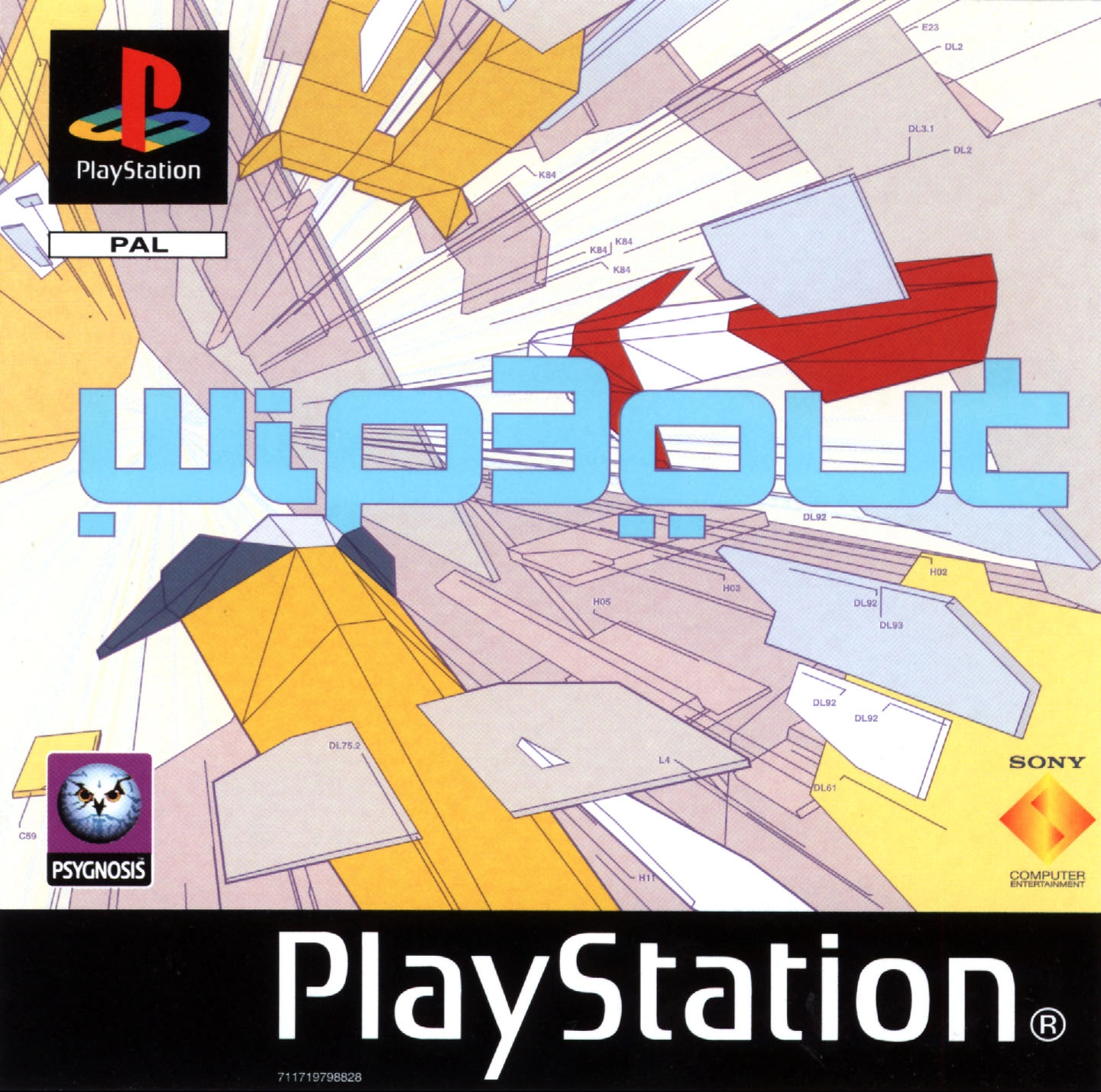| Wipeout 3 | |
|---|---|
 European cover art | |
|
Developer(s) |
Psygnosis Leeds |
|
Publisher(s) |
|
|
Platform(s) |
|
|
Release Dates |
Wipeout 3
Special Edition
|
|
Mode(s) |
Single-player |
|
Media |
CD-ROM |
Wipeout 3 (released as Wip3out in Europe and Japan) is a futuristic racing video game developed and published by Psygnosis exclusively for the PlayStation. The title is the fourth game in the Wipeout series, and was released in Europe and North America in September 1999. The game was re-released in Europe as Wipeout 3: Special Edition in August 2000. Players control extremely fast anti-gravity craft and use weapons to force enemies out of the race.
Developer Psygnosis hired design studio The Designers Republic to create a simple colour scheme and design for in-game menus and race courses, to create what a Psygnosis staff member called "a believable future". The game is one of the few PlayStation titles to run in high-resolution mode, offering crisper graphics and visuals. The game soundtrack is composed of techno and electronica tracks selected by DJ Sasha and features contributions by Orbital and The Chemical Brothers.
The game was positively received on release; critics lauded the graphics, music, and minimalist design elements. The high level of difficulty, perceived lack of new content and courses, and lack of new game features were seen as the game's primary faults. Despite generally good press, the game was a financial disappointment. Wipeout 3 was the last title in the series to appear on the PlayStation; the next entry, Wipeout Fusion, was released exclusively for the PlayStation 2 platform in 2002.
Gameplay

Official logo of the F7200 Anti-Gravity Racing League
Wipeout 3 is a racing game that retains the same basic elements of its predecessors, and introduces players to the F7200 Anti-Gravity Race League. Players control futuristic anti-gravity ships owned by racing corporations and pilot them on eight circuits. Each craft is equipped with an energy shield that absorbs damage sustained on the track; if the shield is disabled, the player's craft can be knocked out of the race. Shields are regenerated in a pit lane that is set apart from the main course. The less time spent in the pit lane, the less the shield will regenerate.
In addition to shields, each racing craft contains air brakes for navigating tight corners, as well as a "hyper-boost" option. Players can activate the hyper-boost to increase their speed, but the boost drains energy from the shields, making the craft more vulnerable. Using special speed pads on the course allows players to increase their speed without resorting to the boost.
Scattered across each raceway are weapon grids that bestow random power-ups or items. Wipeout 3 adds new weapons in addition to the five retained from previous games. Several weapons are defensive; for example, the gravity shield protects the craft from attacks and collisions for a time period. Offensive weapons are also available; craft can use rockets, missiles and mines to disable competitors. Players can use an auto-pilot power-up to safely coast through difficult turns.
The default game mode awards medals to the top three finishing hovercraft. Each contestant must reach checkpoints on the course within a certain amount of time, or be ejected from the race. Winning consecutive gold medals unlocks new circuits and hovercraft. Wipeout 3 features several other game modes, including challenges to complete courses in a set time. In the "Eliminator" mode, players gain points for destroying competitors and finishing laps. The "Tournament" mode has players compete on four or eight rounds, with points being awarded on race placement. Players can engage in two-player racing via a split-screen option.
Development
In developing the next entry in the Wipeout series, developer Psygnosis retained many of the developers of the original game in order to preserve the distinctive racing experience of earlier games. At the same time, Psygnosis sought to make the game more accessible to new players of the fast-paced racer, and kept early courses easier for these players; the difficulty was adjusted for later courses so that experts still experienced a challenge. Wipeout 3 was the first Wipeout game to take advantage of PlayStation controllers with analog sticks, used to offer smoother control of the player's craft.
Psygnosis turned to the graphic design studio The Designers Republic to assist in development. The Designers Republic, known for its underground techno album covers, provided "visual candy" to the game graphics, designing the game's icons, billboards, color schemes, and custom typefaces.The look and feel of the futuristic courses was bounded by a desire to retain a believable sensibility; Wipeout 3 lead artist Nicky Westcott said that "Psygnosis tried to make it look like a believable future, instead of making the sky toxic orange with 10 moons flying around and the world gone mad. It's very low-key and a lot more refined." The game graphics were improved over previous games in the series, and the title was the first in the series to run at high-resolution mode (720 x 480, or 480i).
Tracks
Instead of being based on real world environments, all the tracks in the game are based in a fictional location named Mega City.
Special Edition added 8 more tracks, all of which are from the two previous games.
|
Standard tracks: |
Only in Special Edition: |
Prototypes
In addition to the 8 standard tracks, there are four secret prototype tracks (six in the Japanese version and Special Edition). The four standard prototypes are made in wireframe rather than fully rendered. The two secret prototypes appear like normal tracks. They are unlocked by getting all the 64 gold medals in each speed class.
|
Standard prototype tracks:
|
Secret prototype tracks (Only in the Japanese version and Special Edition):
|
Teams
Music
Wipeout 3 contains techno and electronica offerings from various artists, including The Chemical Brothers, Orbital, and Propellerheads. Psygnosis' development manager, Enda Carey, focused on bringing together music early in the game's development cycle, instead of as an afterthought or last-minute addition to the game. Unlike previous soundtracks, Psygnosis selected a single music director, Sasha, who worked with artists to create a cohesive soundtrack. Sasha included several of his own tracks made specifically for the game. The game disc is a Mixed Mode CD that allows the game soundtrack to be played in a standard compact disc player. To promote Wipeout 3 and its game music, Psygnosis sponsored a Global Underground tour for Sasha. Game pods featuring Wipeout 3 were placed at parties and venues, accompanied by a tie-in marketing campaign.
- Sasha - "FEISAR"
- Underworld - "Kittens"
- Sasha - "Icaras"
- Orbital - "Know Where to Run"
- Sasha - "Auricom"
- MKL - "Surrender"
- Propellerheads - "Lethal Cut"
- Sasha - "Goteki 45"
- The Chemical Brothers - "Influence"
- Sasha - "Pirhana"
- MKL - "Control"
- Paul van Dyk - "Avenue"
- Sasha - "Xpander"
Reception
Aggregator Score
- GameRankings 87%
- Metacritic 89%
Review scores
- GamePro 5/5
- Game Revolution 8.3/10
- GameSpot 8.3/10
- IGN 9.1/10
Overall, critical reception of Wipeout 3 was positive; the game has an aggregate average of 87% based on 29 reviews at Game Rankings, and a metascore of 89 at Metacritic. IGN named Wipeout 3 the most accessible game of the series, and in 2007 the title was named the 92nd best game by the site. Despite generally positive reviews of the game, Wipeout 3 was not a commercial success.
The fast-paced gameplay and graphics were singled out as strong features of the game. Jack Schofield of The Guardian was surprised by the level of detail, stating that the "graphics are better than you'd expect the PlayStation to deliver." Both GamePro and Game Revolution reviewers praised the new game features, specifically the new weapons and ability to challenge friends via splitscreen. The Designer Republic's style was consistently praised as helping to make the racing locales seem real, though David Goldfarb of the magazine International Design stated that the "techno-meets-Nihonpop-art visuals" had been executed better in previous entries of the series. The soundtrack and sound effects were also lauded.
A major fault reviewers found with Wipeout 3 was the steep learning curve of the game. David Canter of The San Diego Union-Tribune described the difficulty progression as "ludicrous", with the tournament game mode going from "easy as pie to tough as nails". Though the use of the analog stick was positively noted as helping to increase control over the onscreen craft, GamePro found that proper handling required large amounts of patience and practice.
Reviewers who gave Wipeout 3 lower marks noted a sense of disappointment that the series broke little new ground. Stuart Miles of The Times admitted Wipeout 3 was a good game, but felt that he had been expecting much more from the sequel: "It's as if the programmers have concerned themselves more with the overall look and feel, rather than further developing the existing gameplay." Alistair Wallace of Gamasutra, in a retrospective on Wipeout 2097, remembered that, "I enjoyed Wipeout 3 because it was more of the same and I loved it, but I think the series ran out of its innovation. Doing loop the loops isn’t a big deal really." GameSpot summed up its review of the game by judging Wipeout 3 an excellent racer, but not able to beat Wipeout 2097 as the best futuristic racing game of all time.
Special Edition
A special edition of Wipeout 3 was released exclusively in Europe on 14 July 2000.[1] Wipeout 3: Special Edition featured many minor changes to gameplay, such as different craft physics, auto-loading of saves, AI bugfixes, unlock messages, and added eight courses from previous Wipeout titles (three from Wipeout and five from Wipeout 2097) plus two hidden prototype circuits previously only available in the Japanese version of Wipeout 3, for a grand total of 22 tracks.[2] Special Edition also allowed four-person multiplayer, using two televisions and two PlayStation consoles. Wipeout 3 was the last game in the series to ship for the aging PlayStation.[3]
References
| All Wipeout Games |
|---|
| 1990s: WipEout • 2097/XL • 64 • Wip3out |
| PS2/PSP: Fusion • Pure • Pulse |
| PS3/Vita: HD (Fury) • 2048 |
| PS4: Omega Collection |
| Mobile: Merge |
